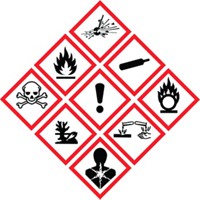Advertisement
Grab your lab coat. Let's get started
Welcome!
Welcome!
Create an account below to get 6 C&EN articles per month, receive newsletters and more - all free.
It seems this is your first time logging in online. Please enter the following information to continue.
As an ACS member you automatically get access to this site. All we need is few more details to create your reading experience.
Not you? Sign in with a different account.
Not you? Sign in with a different account.
ERROR 1
ERROR 1
ERROR 2
ERROR 2
ERROR 2
ERROR 2
ERROR 2
Password and Confirm password must match.
If you have an ACS member number, please enter it here so we can link this account to your membership. (optional)
ERROR 2
ACS values your privacy. By submitting your information, you are gaining access to C&EN and subscribing to our weekly newsletter. We use the information you provide to make your reading experience better, and we will never sell your data to third party members.
Safety
Making Explosives In The Lab
Researchers impress on students the importance of safety
by Jyllian Kemsley
January 7, 2008
| A version of this story appeared in
Volume 86, Issue 1

LABORATORY SAFETY is a concern for all chemists, but it takes on a whole new meaning when one is synthesizing highly energetic or explosive materials.
Darryl DesMarteau, a chemistry professor at Clemson University, knows the dangers all too well. A laboratory accident when he was a graduate student led to the loss of his left hand and part of his right hand. During an experiment, he had accumulated about 200 g of F2SO3, which exploded unexpectedly. "I didn't even want it but decided to save it," DesMarteau says. "That turned out to be a bad decision."
What exactly happened in the lab that day is still a bit of a mystery, but hydrocarbons can sometimes initiate a chain decomposition of peroxygen and oxygen-halogen compounds. DesMarteau now believes that a hydrocarbon contaminant set off the F2SO3 explosion. The people in the lab "should have known better, but we didn't," he says. "We just assumed that the stuff was okay if handled properly, and that assumption was wrong."
Working with highly energetic materials can be a challenge even for seasoned researchers, never mind inexperienced students. Something as innocuous as a bit of material caught on the threads of a screw-top vial, for example, can lead to an explosion in a student's hands if that material is sensitive to friction. DesMarteau and others in the field put a high priority on investing the time to develop and enforce lab safety protocols, promote communication in laboratories, dispose of materials promptly, and even cull insufficiently careful students from groups.
For his part, more than four decades after his accident, DesMarteau still works with fluorine compounds. A major focus of his group now is synthesizing fluorinated electrolytes for lithium batteries and fuel-cell membranes. He says laboratory safety is an important part of his group's ethos.
"If you work with energetic materials, which for us are mainly compounds that have relatively weak bonds, then you have to assume that they can be hazardous," DesMarteau says. "So everything you do is built around that [assumption]." The most important thing when handling energetic materials, he notes, is to work with small quantities. His students and postdocs work on vacuum lines that allow them to manipulate and characterize small amounts of compounds—at most a few hundred milligrams.
Jean'ne M. Shreeve is a professor of chemistry at the University of Idaho, and one focus of her research program is developing high-nitrogen compounds—such as triazole and tetrazole derivatives—for explosives and propellants. She says that her group collectively has put together basic guidelines regarding appropriate lab safety, and she discusses those rules with prospective students one-on-one before they join the group.
One of those rules is that students must fill out a form before starting a reaction, describing the chemistry they'll do and the hazards of any chemicals involved. Shreeve also implemented a buddy system in her group, requiring students to discuss experiments and safety considerations both with her and with their lab buddy. "It gets people talking to each other, makes people aware of what others in the group are doing, and helps in identifying flaws or dangers in the procedures," Shreeve tells C&EN.
Thomas M. Klapötke, a chemistry professor at Ludwig Maximilians University, Munich, has perhaps the most rigorous approach to training students in the art of synthesizing energetic compounds. Klap??tke's research program focuses on creating new materials to replace the nitramines RDX and HMX, commonly used military explosives.

In Klapötke's lab, undergraduate students never handle energetic materials. Starting at the master's level, students coming into the lab must first synthesize no more than 250 mg of a secondary explosive, a compound such as TNT that is very energetic but has a high activation barrier. They then characterize the sample, determining the impact, friction, and electrostatic sensitivity of the material.
Having successfully completed that synthesis, a student then will synthesize and characterize a small amount of a primary explosive—such as lead diazide—a compound that is less energetic than a secondary explosive but is more sensitive and carries a higher risk of explosion.
THIS APPROACH of practice syntheses gives students the feel for the materials they might handle, Klapötke says. In particular, if they're synthesizing a new, unknown compound, they have to treat it as if it's a primary explosive. It also gets students used to working in full protective gear: a helmet with face shield, leather jacket, and grounded shoes.
Only after students have completed a master's degree and are working toward a doctorate do they get to synthesize unknown materials. As in Shreeve's group, students must fill out a form outlining the proposed reactions, quantity of materials, known safety hazards, and disposal procedures for every experiment. Klapötke or a senior member of the group must approve each proposed experiment.
Syntheses are normally done only at the 150- to 250-mg scale, and larger quantities are prepared only after compounds are fully characterized and their properties are well-understood. Any synthesis larger than 5 g is done in the company of Klapötke or a senior member of his group.
At the end of the day, safe disposal of compounds and waste products is another important consideration. "Waste disposal is a major issue no matter what kind of chemistry you're doing, but for us it's particularly important," Shreeve says. It's critical to impress on students not only to store compounds safely while they're studying them, she says, but also to store them no longer than necessary.
Both Klapötke and DesMarteau have refused to work with students who may be a safety hazard. Klapötke declined to let a student advance to Ph.D.-level work after the student repeatedly scaled up syntheses without permission. DesMarteau asked a student to leave after the student let their spouse use the group's vacuum line to pump off an organic solvent, and the next day the residue caused another student's compound to explode. No one was hurt, but "sometimes people do something stupid and you can't take the risk that they will do it again," DesMarteau says.
One overarching safety concern among investigators of highly energetic materials is loss of knowledge and experience as faculty age. Funding for projects is scarce, they say, and so younger researchers aren't maintaining and developing the skills they may have learned as graduate students. "Once that knowledge is gone it's very difficult to get it back," Klapötke says.
"I was on a National Research Council committee recently dealing with energetics, and this issue came up over and over again," Shreeve tells C&EN. "The people who make their living in this field are dying off, and who's going to take their places?" She says that there is some effort to encourage funding agencies to support research in the area of energetic materials, preserving not only scientific knowledge but the ability to pursue new research safely.








Join the conversation
Contact the reporter
Submit a Letter to the Editor for publication
Engage with us on Twitter